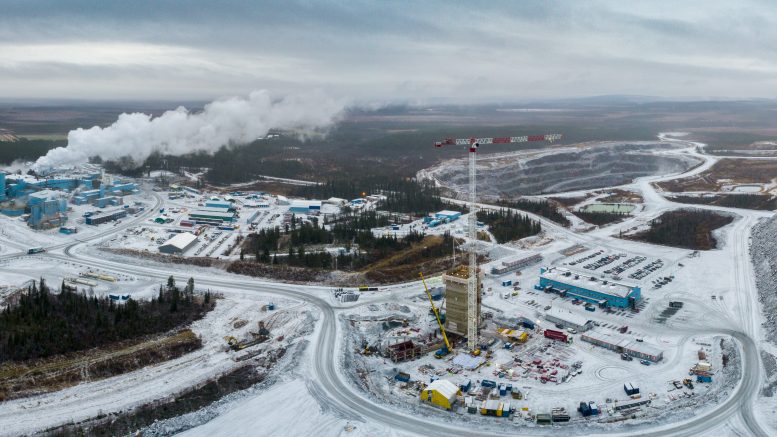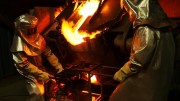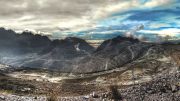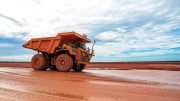Agnico Eagle Mines (TSX: AEM; NYSE: AEM) is taking a 9.9% stake in Rupert Resources (TSXV: RUP) and the junior’s flagship Pahtavaara gold project, located 50 km away from Agnico’s Kittila mine in Finland.
Rupert Resources owns 100% of the permitted Pahtavaara gold mine and mill on a 300 sq. km. land package in northern Finland’s Central Lapland Greenstone Belt.
Pahtavaara is located about 20 km from the significant polymetallic deposits at Boliden’s Kevitsa nickel, copper, PGM mine — one of the largest-ever mineral discoveries in Finland — and Anglo American’s (LSE: AAL; US-OTC: AAUK) Sakatti copper-nickel-PGM project.
Pahtavaara previously produced more than 420,000 oz. gold over a 16-year period of open-pit and underground operations and last operated in May 2014. The project has an inferred resource estimate from 2018 of 4.6 million tonnes grading 3.2 grams gold per tonne at a 1.5 gram gold cut-off grade for 474,000 ounces.
Agnico is investing $13.1 million (US$9.8 million) for 15.3 million units in the junior exploration company at 85¢ per unit. Each unit consists of one common share and 0.75 of a common share purchase warrant, which will allow the gold major to purchase one common share for each whole warrant at a price of $1.00 per share for a period of three years. If Agnico exercises all of its warrants, it will own 16.1% of the company.
The Toronto-based gold major also has the right to maintain its ownership thresholds in the company, and can nominate one person to Rupert Resources’ board of directors.
The investment is expected to fund Rupert Resources’ exploration campaign for at least 12 months.
“It’s fantastic news for the company and I can’t think of a better partner to have in the region, given they own and operate the Kittila mine — Europe’s largest gold mine,” James Withall, Rupert Resources CEO said in an interview from London. “It’s a great validation of what we’ve been doing and the approach we’ve had to exploration.”
Withall, who worked as an exploration and production geologist in Australia for eight years and then spent thirteen years as a partner and fund manager at Baker Steel Capital Managers, one of the largest London-based mining specialized funds, said he recognized that Rupert Resources had a special project on its hands.
“I looked at Pahtavaara as a fund manager when Rupert first acquired it in 2016 because I knew the founders and shareholders and at that point what really got me interested was that they bought this permitted mine and mill for only US$500,000 and they also had this huge land package in the heart of this greenstone belt that had been staked by previous owners in 2011 but they had done almost no regional exploration on it,” he says. The price-tag included a 1.5% royalty on any future production from the mine capped at US$2 million.
He also appreciated the fact that previous owners had spent about US$40 million on the project, and that there was historical drill data and 35 km of underground tunnelling to a depth of 450 metres.
Withall decided to leave Baker Steel and join the junior as CEO in April 2017.
He and his team spent the first 18 months re-evaluating the tens of millions of dollars worth of information that had been collected about the asset — which included extensive geophysics from the government and previous owners and half a million metres of drilling almost entirely at the Pahtavaara mine.
“I brought in people I knew to help me look at the ground to see if they agreed with me that it was a prospective land package and they agreed. From there we built a regional structural model on a 100 km by 100 km area and confirmed the licences we held were sufficient over some of the key controlling regional structure,” he says. “We then spent time deciding what was the most effective way to do exploration because it’s under 5-10 metres of glacial till (there had been three episodes of glaciation) so we had very little outcrop to work with and we had to use an exploration method that would work in that environment.”
Ultimately, they chose a combination of base of till drilling, which had been used with great success to discover Anglo American’s nearby Sakatti project, and detailed geophysics. Base till drilling is a method whereby a hole is drilled through the glacial till to the top of the bedrock in order to retrieve a sample of the till directly from the till/bedrock contact, which is then assayed for multiple elements including gold.
“It’s the most reliable way we have of understanding the potential for mineralisation in the underlying lithology,” Withall explains. “Sample spacing is typically 25 metres along sampling lines that can be up to 2 km long across prospective areas chosen by interpreting airborne and ground geophysics (mag, gravity and electromagnetics). We also retrieve chip samples of the bedrock itself that we can use to build up maps of the geology under areas of glacial till cover.”
In May 2019, a detailed ground gravity survey over 200 sq. km of the licence, new interpretation of existing geophysical data, and new drilling culminated in the discovery of new incidences of gold mineralization about 25 km from the Pahtavaara mill and a part of the property they called Area 1.
Significant intercepts in drillhole 119032 included 10.5 metres grading 3.55 grams gold per tonne starting 90 metres below a base of till anomaly of 21 grams gold per tonne. Drillhole 119033 intersected 2 metres grading 3.4 grams gold per tonne along with broad zones of lower grade gold and copper mineralization associated with sulphides throughout the length of the hole.
Withall says these are the first gold discoveries ever made under cover in Finland that he knows of. Agnico Eagle’s Kittila deposit was discovered during a road cutting, he says, and the Pahtavaara deposit was found on a hill outcrop.
“There are plenty of gold occurrences and outcrops in this part of the world but these are the first major ones under cover and we’re beginning to demonstrate that the geology is quite different than what the geological maps have said was there based on the geophysics,” he says. “With base of till drilling we’re going to show that the prospectivity of the belt is higher than what we had assumed as well.”
Rupert Resources has four drill rigs at the project — two undertaking expansion drilling near the Pahtavaara mine and resource (7,000 metres planned this year) and the other two drilling regional targets (15,000 metres planned this year).
Among the best intercepts of the regional drill program released so far are from drillhole 119049, which intersected two breccia zones. Among the highlights were 19 metres of 0.6% copper and 0.7 gram gold per tonne from 125 metres, including 3 metres of 1.6% copper and 0.3 gram gold per tonne, and 37.5 metres of 0.8% copper and 0.4 gram gold per tonne from 154 metres downhole, including 1 metre of 1.6% copper and 0.3 gram gold per tonne. Drillhole 119062 returned 10.6 metres of 3.3 grams gold per tonne and 1.5% copper from 84 metres.
Highlights from the 7,000-metre near-mine and resource drill program that began in October include drillhole 119503, which cut 5.6 grams gold per tonne over 6 metres from 69 metres downhole and 13.8 grams gold per tonne over 3 metres and 62.7 grams gold per tonne over 11.9 metres from 170 metres downhole. Hole 119507 intersected 220.3 grams gold per tonne over 5 metres from 150 metres, including 2 metres of 550 grams gold per tonne.
“We’re about 10,000 metres into our 15,000-metre program and we’re continuing with our base till rig and continue to find new targets that we’re following up on,” Withall says, noting that the plan is to sequentially test between six and eight regional targets.
But he says the company is taking a “patient” approach and “only looking for deposits of scale — something with a net smelter value of over US$2 billion.”
“It’s got to be significant to ourselves and to a major company in the industry,” he explains. “It’s not designed to find 200,000 to 300,000 oz. size deposits. While we hope to find a number of those along the way, which could be processed at the Pahtavaara mill, we’re constantly re-assessing exploration based on discoveries that have the potential to yield a far greater scale.”
Agnico’s Kittila operation produces about 200,000 oz. gold a year. The underground mine turned out 189,000 ounces of gold in 2018 at cash costs of $853 per oz. gold.
Kittila is undergoing an expansion to increase throughput to 2 million tonnes per year from 1.6 million tonnes per year. The expansion involves building a 1,044-metre deep shaft, a processing plant expansion and other infrastructure and service upgrades between 2018 and 2021.
In addition to Pahtavaara, Rupert Resources owns 100% of two properties in central Finland — Hirsikangas and Osikonmaki — as well as the Gold Centre property in Red Lake, Ontario, and the Surf Inlet property in B.C.
At presstime in Toronto Rupert Resource’s shares were trading at 84¢ within a 52-week range of 65¢ and $1.00 apiece. The junior has 135 million common shares outstanding for a market cap of $118 million.






Be the first to comment on "Agnico Eagle takes strategic stake in Rupert Resources"